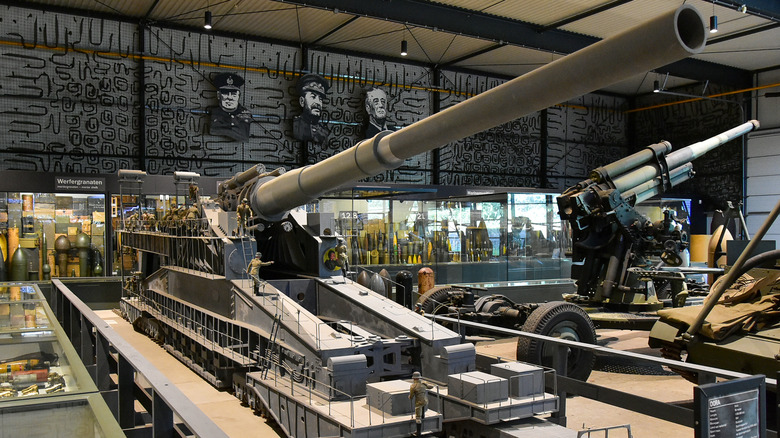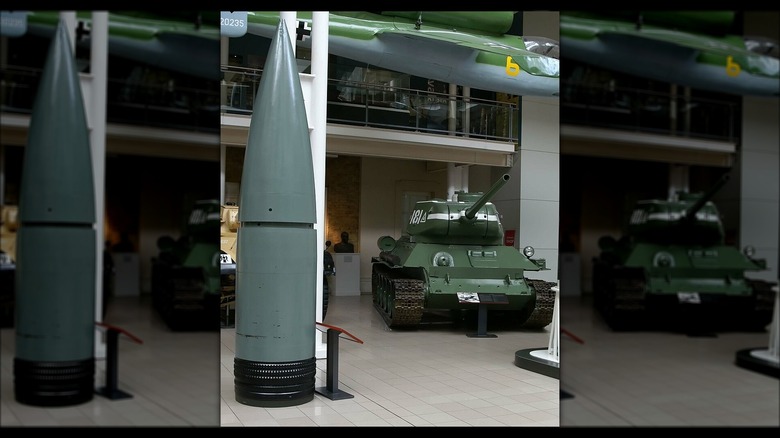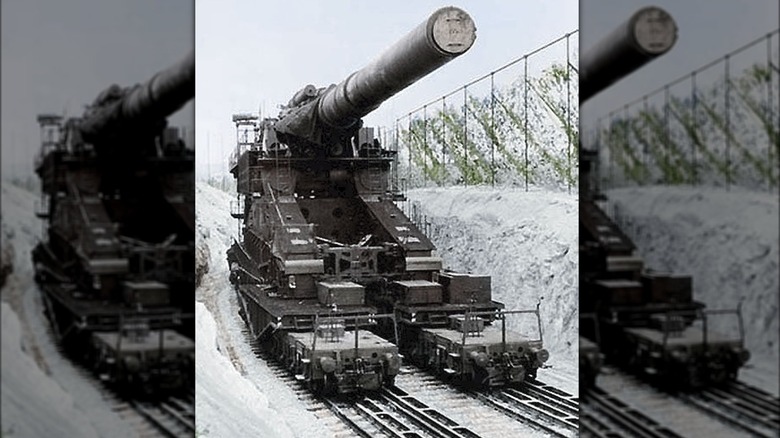The Biggest Gun Ever Used In Combat: Germany's Schwerer Gustav
There are guns, there are really big guns, and then there's the Schwerer Gustav. Before we dive into the specifics of this bigger-than-life gun, we need to know why Hitler wanted it built. Other than the fact that it was Hitler doing "Hitler things," of course.
France began building the Maginot Line in 1929, a 280-mile-long defensive fortification that started on the French side of the English Channel, and stretched south to the French-Swiss-German border. It was constructed using 55 million tons of steel and 1.5 million cubic meters of reinforced concrete.
With the aftermath of World War I still relatively fresh in their minds, France meant for it to protect them from Germany should it decide to flex its muscles again. The structure consisted of over 140 artillery forts, 350 gun emplacements, and as many as 5,000 other bunkers, storehouses, and barracks. It even had an underground railway to move soldiers and ammunition wherever needed.
No one seems to agree on a single completion date, with years ranging from 1934 to 1936, and even as late as 1939. Whatever the actual date, by 1934, Hitler already knew he was going to invade France because that's when he ordered the Nazi high command (Oberkommando des Heeres) to commission a weapon that could penetrate and destroy the walls and fortifications found along the Maginot Line.
[Featured image by Paul Hermans via Wikimedia Commons | Cropped and scaled | CC BY-SA 4.0]
A big gun required big ammo
The high command tabbed Essen-based weapons producer Friedrich Krupp AG to build a bunker-busting weapon that, first and foremost, could bust through walls made of three feet of layered steel or 23 feet of reinforced concrete. It had to accomplish this by firing at the target from a considerable distance to avoid vulnerability as well. What Krupp AG created was the largest, heaviest piece of artillery ever used in combat.
To say the Heavy Gustav was massive is actually an understatement. The entire rig was over 150 feet long, 40 feet tall, and weighed nearly 1,500 tons. The barrel alone was 100 feet long and had a 31-inch-wide bore that fired two different 80cm (800mm) caliber shells measuring over 2.5 feet wide and 12.5 feet long.
The five-ton high explosive round carried over 1,500 pounds of explosives, made an impact crater almost 30 feet wide and 30 feet deep and could hit a target downrange nearly 30 miles away. The heavier seven-ton armor-piercing round contained just over 550 pounds of explosives and had an effective target range of around 23 miles. Given the size of the shells, it could only fire 14 projectiles a day.
Because the Gustav was gigantic, it could only move by rail, but not just any old train track would do. It required dual tracks running in parallel, and because these were specially designed and dedicated solely to its use, they had to be built on demand to travel anywhere.
[Image by Megapixie via Wikimedia Commons | Cropped and scaled | CC BY Public Domain]
Who knew a gun could be so high-maintenance?
Thus, this high-maintenance gun required a crew of between 250 and 500 men to fire and operate, and another 2,000-4,000 to protect, move, lay track, and reassemble. Yes, reassemble. It was so heavy that it had to be broken into five pieces to meet rail weight restrictions. Once moved, it took thousands of soldiers and engineers more than three days to set back up.
Since the barrel could only move up and down (not side to side), it had to be aimed by hauling the entire apparatus to a bend in the track that afforded proper targeting coordinates. There was one other hiccup: Allied bombers could easily spot the hulking gun — not to mention its unique track layout — from the air, making it a very enticing target.
Delays in producing Gustav's colossal metal sheets pushed its completion date out further than expected. Ironically, it was never needed at the Maginot Line. Instead of attacking France head-on, Hitler went through Belgium, avoiding it almost entirely, and France surrendered only six weeks after Germany invaded on May 10, 1940.
Gustav was used in the Spring of 1942 during the Siege of Sevastopol in Crimea, where it fired 48 total shells, one of which reportedly had such incredible destructive power that it was able to punch through 100 feet of ground before exploding inside a bunkered, underwater ammunition's depot.
[Image by Schwerer Gustav via Wikimedia Commons | Cropped and scaled | CC BY-SA 2.0]
Gustav did not equate to more bang for the buck
Hitler loved the Gustav, but according to some accounts, many officers and soldiers who operated the beast did not. In fact, it's very possible the hate was so great they mockingly referred to it as "Dora." Here's where things get murky: several sources claim that two heavy guns were built and that the second gun — nicknamed "Dora" — was sent to Stalingrad for use against the Soviets. As the story goes, the time required to assemble the gun was so great it gave the Soviet army enough time to surround the Germans and run them off before being used.
Conflicting stories exist of this second gun. Some say they retreated with the gun, while others saying it was left it behind, studied, and eventually dismantled or blown up — to be later discovered in ruins by American soldiers. A photograph showing servicemen sitting on a long barrel has since been determined not to be a Gustav-level heavy gun.
The only other recorded use of Gustav (not Dora) was in 1944, when the Germans used it to lob approximately 30 shells into the city of Warsaw to break up a riot. After that, it vanishes into history.
Gustav cost an estimated 10 million German Marks to build, was used twice, and fired less than 100 rounds. While it was the biggest gun used in combat, it was not the biggest gun ever built. That claim to fame lies with "Little David," a 36-inch (914 mm) cannon built by the U.S. Army to use against Japanese bunkers. Fortunately, the Japanese surrendered before it was ever needed.


